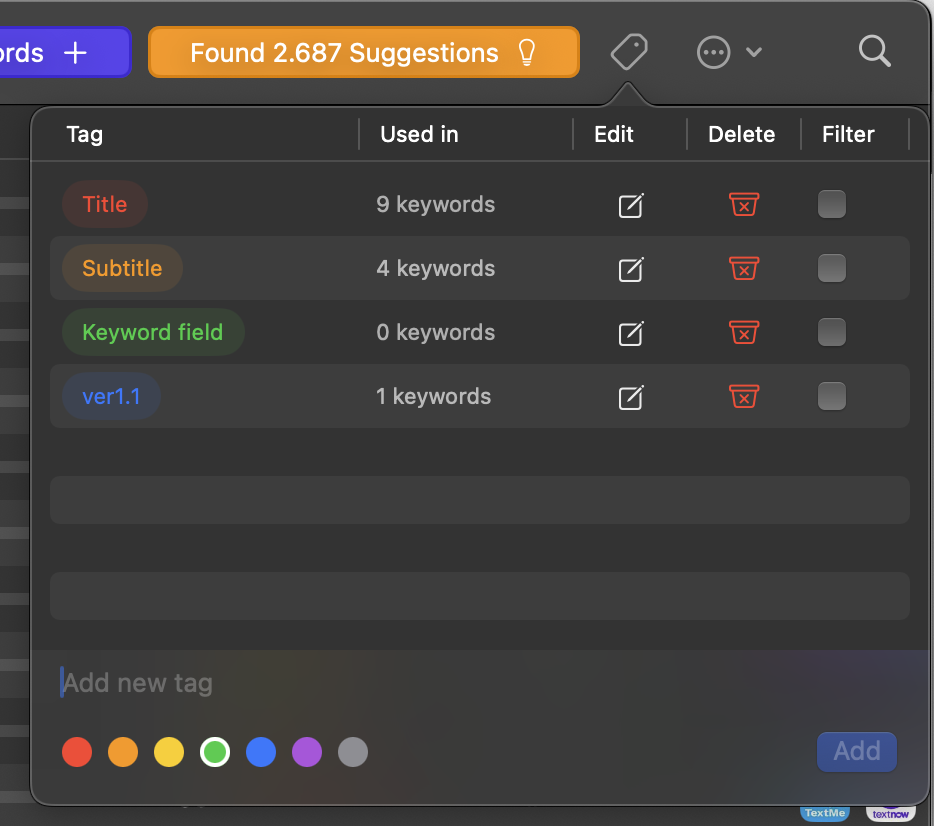Tags
Create complex filters using tags to organize your keywords

Tags are the best way to filter and group your keywords based on specific needs. They provide a powerful organization system that allows you to manage large keyword lists efficiently.
With tags, you can categorize keywords by their purpose, location in your app metadata, performance level, or any other criteria that makes sense for your workflow.

How to Create a Tag
Creating a new tag is simple and straightforward:
- Click the “Add Tag” button in the navigation bar
- Enter the tag name in the keyword field
- Select a color for easy visual identification
- Click “Add” to create the tag
Each tag can be assigned a unique color to help you quickly identify different categories at a glance.
Editing a Tag
To modify an existing tag:
- Click the “Edit” button next to the tag you want to modify
- Change the title or select a different color
- Click “Update” to save your changes
You can update both the name and color of any tag at any time without affecting the keywords already assigned to it.
Deleting a Tag
To remove a tag from your system:
- Click the “Delete” button next to the tag you want to remove
- Confirm the deletion when prompted
Important: Deleting a tag will not remove the keywords associated with it. The keywords will remain in your list but will no longer be tagged with the deleted tag.
Filtering Keywords by Tags
The tag filtering system allows you to create sophisticated views of your keyword data:
- Check the filter checkbox in the filter column next to any tag
- Select multiple tags simultaneously to create complex filtered views
- Combine different tags to narrow down your results
Example: If you have a “Favorites” tag and a “Title” tag, you can select both to view all your favorite keywords that appear in your app’s title.
This filtering capability is particularly useful when working with large keyword lists or when you need to focus on specific subsets of your data.
Assigning and Removing Tags
To assign or remove tags from keywords:
- Select one or more keywords (selected rows will highlight in blue)
- Right-click on the selected keywords
- Choose “Add Tag” or “Remove Tag” from the context menu
- Select the appropriate tag from the dropdown menu
You can apply this process to individual keywords or bulk-assign tags to multiple keywords at once, making it easy to organize large datasets quickly.

Tip: Hover over any tag with your mouse to see its full name, which is especially helpful when working with tags that have similar colors.
Common Use Cases for Tags
Tags are versatile tools that can be used for various organizational purposes:
App Metadata Organization
- Title Keywords: Keywords used in your app’s title
- Subtitle Keywords: Keywords included in the subtitle
- Keywords Field: Keywords added to the app’s keyword field
Performance Tracking
- High Performers: Keywords with excellent ranking positions
- Opportunities: Keywords with potential for improvement
- Favorites: Your most important or strategic keywords
Campaign Management
- Version Specific: Keywords assigned to specific app versions
- App Events: Keywords to use in App Store event naming
- Seasonal: Keywords for holiday or seasonal campaigns
Competitive Analysis
- Competitor Keywords: Keywords discovered from competitor research
- Market Research: Keywords for market validation
- Trending: Keywords gaining popularity in your niche
By implementing a consistent tagging strategy, you can transform your keyword management from a simple list into a powerful, organized system that supports your ASO strategy effectively.
Still have questions? Write us an email.